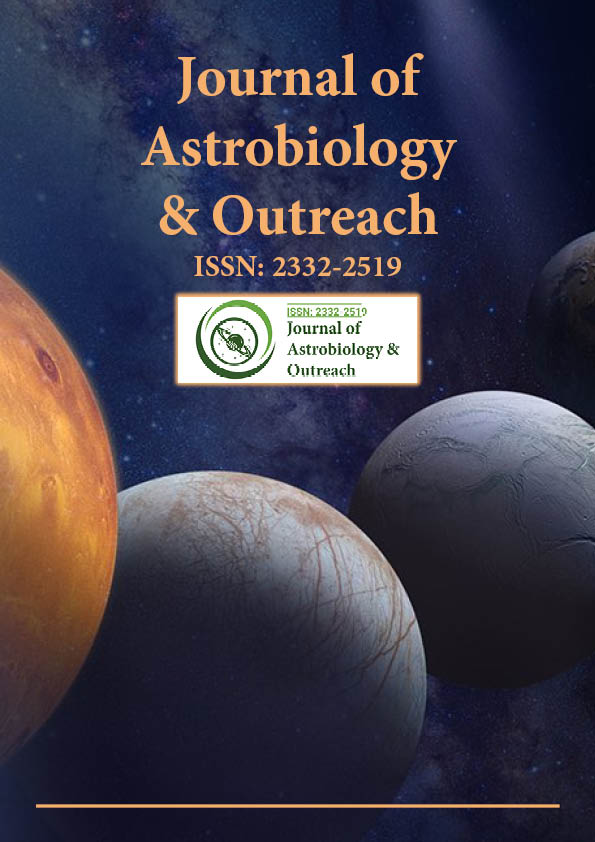Indexed In
- Open J Gate
- Academic Keys
- JournalTOCs
- RefSeek
- Hamdard University
- EBSCO A-Z
- OCLC- WorldCat
- Google Scholar
Useful Links
Share This Page
Journal Flyer

Open Access Journals
- Agri and Aquaculture
- Biochemistry
- Bioinformatics & Systems Biology
- Business & Management
- Chemistry
- Clinical Sciences
- Engineering
- Food & Nutrition
- General Science
- Genetics & Molecular Biology
- Immunology & Microbiology
- Medical Sciences
- Neuroscience & Psychology
- Nursing & Health Care
- Pharmaceutical Sciences
Commentary - (2023) Volume 11, Issue 4
Exploring Astrobiology in Simulated Martian Conditions
Sephton Ricco*Received: 03-Jul-2023, Manuscript No. JAO-23-23361; Editor assigned: 05-Jul-2023, Pre QC No. JAO-23-23361 (PQ); Reviewed: 19-Jul-2023, QC No. JAO-23-23361; Revised: 26-Jul-2023, Manuscript No. JAO-23-23361 (R); Published: 03-Aug-2023, DOI: 10.35248/2332-2519.23.11.309
Description
Astrobiology, the scientific study of life's existence beyond Earth, is a field rife with intrigue and profound questions. The prospect of life existing elsewhere in the cosmos has long captivated human imagination. Among the myriad celestial bodies within our reach, Mars stands as one of the most compelling candidates for astrobiological exploration. Its similarities to Earth, particularly in its distant past, make it an interesting subject of study.
Mars, often referred to as the "Red Planet," is Earth's closest planetary neighbor and has captivative scientists and space enthusiasts for centuries. Its allure lies in its resemblance to Earth's surface features and a climate that hints at the possibility of past liquid water. These factors, coupled with its proximity, make Mars a prime target for astrobiological exploration.
However, Mars today is a cold and isolated world with a thin, predominantly carbon dioxide-based atmosphere. Its harsh conditions, characterized by low atmospheric pressure and extreme temperature fluctuations, pose significant challenges to the survival of life as we know it. Nevertheless, the history of Mars, including the presence of water and the potential for a more robust atmosphere in the past, fuels hope for extraterrestrial life or its remnants.
To discover the unknown life on Mars, scientists engage in experiments conducted within controlled environments that replicate the Martian atmosphere. These simulated Martian atmospheres are important for investigating the resilience of microorganisms and assessing the feasibility of biochemical processes under Martian-like conditions.
The Martian atmosphere comprises primarily carbon dioxide (approximately 95%) with trace amounts of nitrogen and argon. The thin atmosphere and low atmospheric pressure on Mars, combined with its exposure to high levels of radiation, demand laboratory environments that accurately mimic these conditions. These controlled settings enable the study of extremophiles— microorganisms capable of thriving in extreme environments.
Extremophiles, resilient organisms that flourish in harsh environments on Earth, provide valuable insights into the potential for life beyond our planet. In simulated Martian atmospheres, researchers have uncovered surprising findings about certain extremophiles, notably halophiles. Halophiles thrive in high-salt environments and have demonstrated resilience to extreme desiccation and low-pressure conditions resembling those on Mars. These discoveries raise intriguing questions about the adaptability of life to extreme environments and whether analogous microorganisms could endure on Mars.
Despite these potential findings, we must acknowledge the numerous challenges life would encounter on Mars. The absence of a stable energy source, scarcity of liquid water, and elevated radiation levels are formidable obstacles to the survival and proliferation of potential Martian life forms. A tantalizing possibility is the existence of subsurface life on Mars. Martian soil may conceal pockets of water ice, and some scientists hypothesize the presence of deep underground aquifers that could provide a suitable environment for microorganisms. Such subsurface environments offer protection from harsh surface conditions and access to vital resources like water, enhancing the prospects of life on Mars.
Another pivotal aspect of astrobiology is the search for organic molecules on Mars. Organic molecules, consisting of carbon and hydrogen atoms, serve as the fundamental building blocks of life as we know it. Remarkably, evidence of complex organic molecules has been detected on the Martian surface by NASA's Curiosity rover within the Gale Crater. This discovery suggests that the necessary chemical ingredients for life exist on Mars.
Furthermore, the detection of methane in the Martian atmosphere has captured scientific attention. Methane can result from geological processes or biological activity. Its presence sparks intriguing questions about the potential existence of microbial life deep beneath Mars' surface.
The exploration for life on Mars remains an ongoing and evolving mission, with forthcoming missions aiming to explore the planet's surface and subsurface in greater depth. NASA's Perseverance rover, which successfully landed on Mars in early 2021, carries sophisticated instruments designed to search for signs of past microbial life and collect samples for eventual return to Earth. Additionally, international collaborations such as the European Space Agency's ExoMars program aim to investigate the Martian surface and subsurface comprehensively. These missions signify significant strides in our pursuit of comprehending the potential for life beyond Earth.
Astrobiology is a field that continually pushes the boundaries of our knowledge regarding the existence of life beyond our planet. The exploration of Mars, within the confines of simulated Martian atmospheres and through ongoing missions, stands at the forefront of astrobiological research. While conclusive evidence of extraterrestrial life has yet to be discovered, the revelations made on Mars, including the detection of organic molecules and the resilience of extremophiles in simulated Martian conditions, underscore the significance of the Red Planet in the quest for extraterrestrial life.
Citation: Ricco S (2023) Exploring Astrobiology in Simulated Martian Conditions. J Astrobiol Outreach. 11:309.
Copyright: © 2023 Ricco S. This is an open-access article distributed under the terms of the Creative Commons Attribution License, which permits unrestricted use, distribution, and reproduction in any medium, provided the original author and source are credited.

